Introduction
That means that if you’re part of an educational company, most of the marketing tactics that work for other companies just won’t work for you.
But don’t worry! I’ll take you through several specific tactics that educational companies have used to grow their business, so you can see exactly what sorts of strategies and tactics could potentially work for your specific situation.
Before we get into that, let’s dig into the different business models in the world of education technology.
Table of Contents
Business Models in EdTech
There are different business models in EdTech that can be pursued depending on who your target customer is. Here’s a quick summary of some major ones:The Freemium Model
The freemium pricing model is based on offering a version of the main product for free and then charging those who want to upgrade to a more advanced product.
MasteryConnect is an example of a product that does exactly this. Their product helps both parents and teachers stay on the same page regarding student progress. The data they collect also helps parents and teachers create targeted intervention programs for students who might be at risk of failure, dropping out, etc.
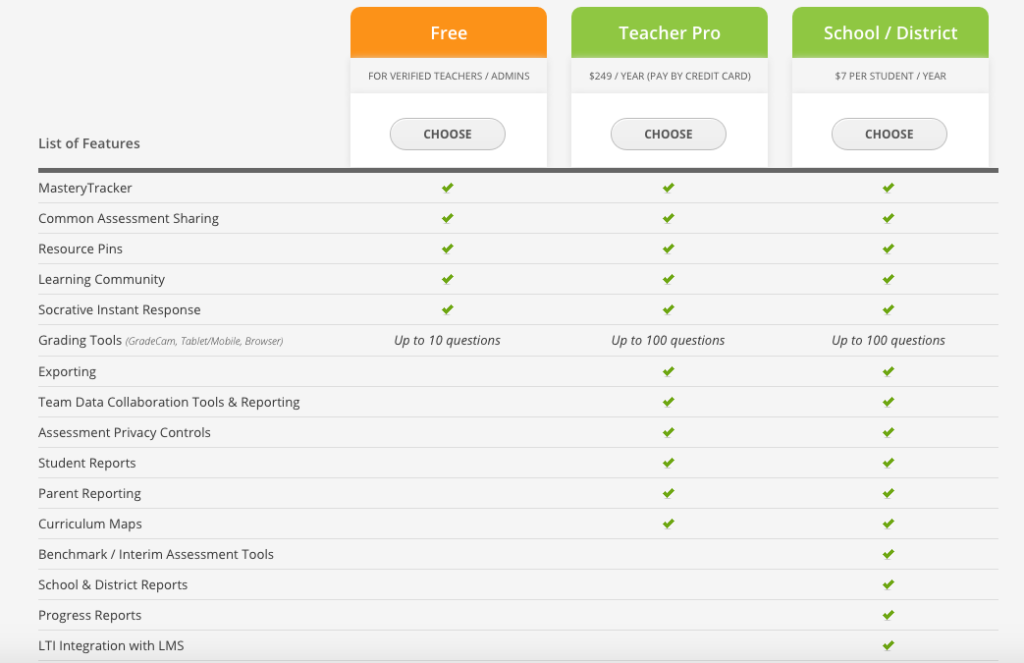
Some companies, like Quizlet, target students specifically instead of teachers. Quizlet starts their users off with a free plan to help them study for exams, which includes a certain number of “flashcards” to help students study. For more flashcards or a more sophisticated plan that includes online groups, enhanced audio, etc., they have a Quizlet Plus Plan for $19.99 / year.
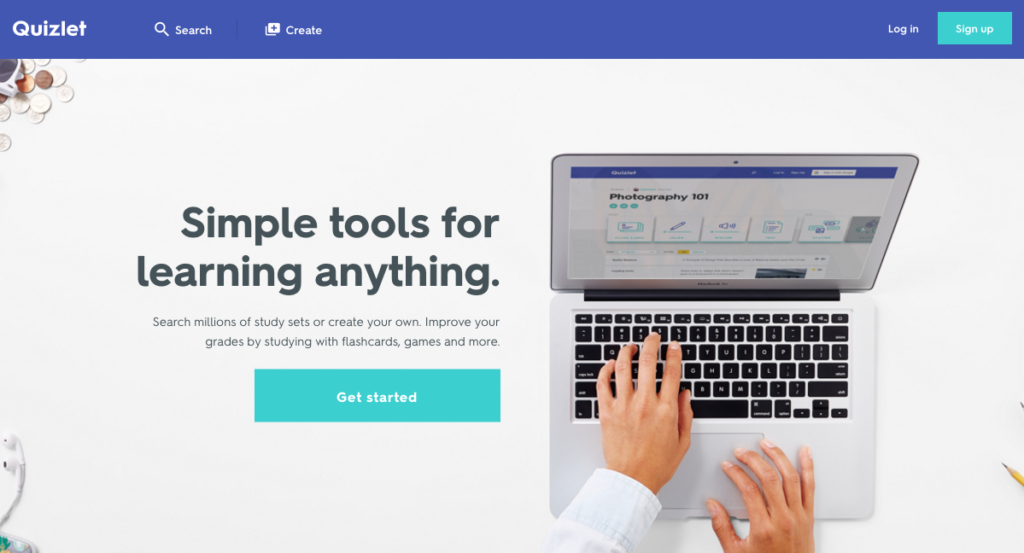
Some companies target freemium plans at schools, with the goal of getting students and teachers to influence the decision makers at the top.
TeachBoost, a company that helps schools maintain efficient processes, uses this model successfully. Selling to schools is notoriously hard, so TeachBoost focuses on getting principals at schools on their system first with the idea that the principals will act as advocates to influence the decision makers at the head of the school.
Some education companies, like Clever, use another type of freemium business model that involves selling products to other education companies. For example, they might offer their product for free to one audience, and charge other company a fee for access to distribution. Clever reached 70% of K-12 schools in the U.S. by using this strategy, and claimed 89 out of the top 100 school districts as Clever users.
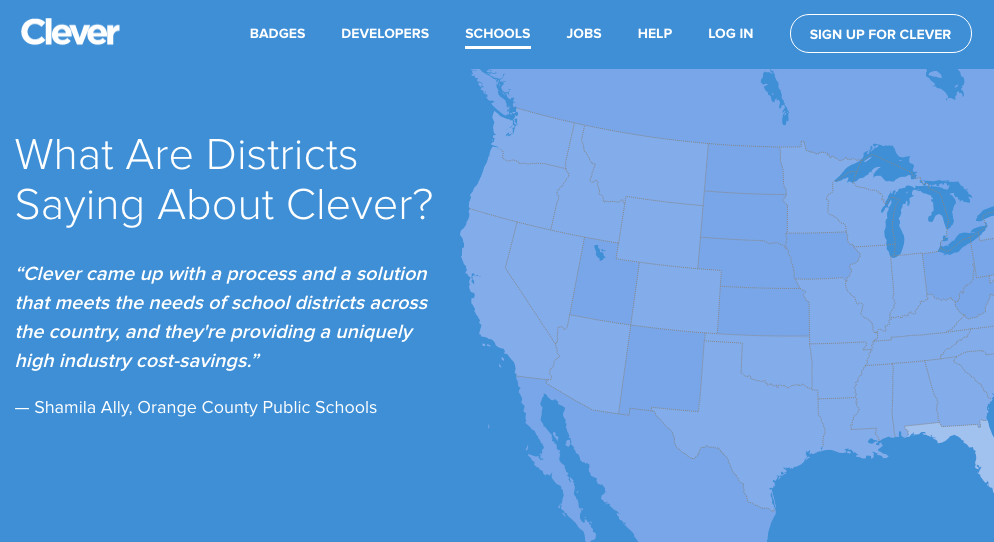
Once they get schools as users, Clever gathers and interprets their data, and ultimately sells the data to other startups that want to connect with schools.
Enterprise sales
Some education products that target schools are very comprehensive, containing a variety of features specific to the needs of school systems. In this case, they’d have to target schools directly, without going through students first.
Panorama Education is one of these companies. They’re a data analytics company that help schools collect analyze the feedback from students. Of course, this isn’t a product that students could use on their own without collaboration from the school system.
Dreambox Learning is another example. They have an “Intelligent Adaptive Learning” tool that they sell directly to school districts.
Direct to consumer
Direct to consumer businesses target parents as their end customers, without the intention of going through them to get to schools. However, a viable strategy for these types of business is going through students to get to parents. For example, a business that sells directly to consumers could have a tool that serves students, and use students as a “gateway” to get parents on board.
Companies like Educator sell subscription plans directly to consumers — users have the option to purchase plans to go through full lessons on K-12 topics such biology, calculus, etc.
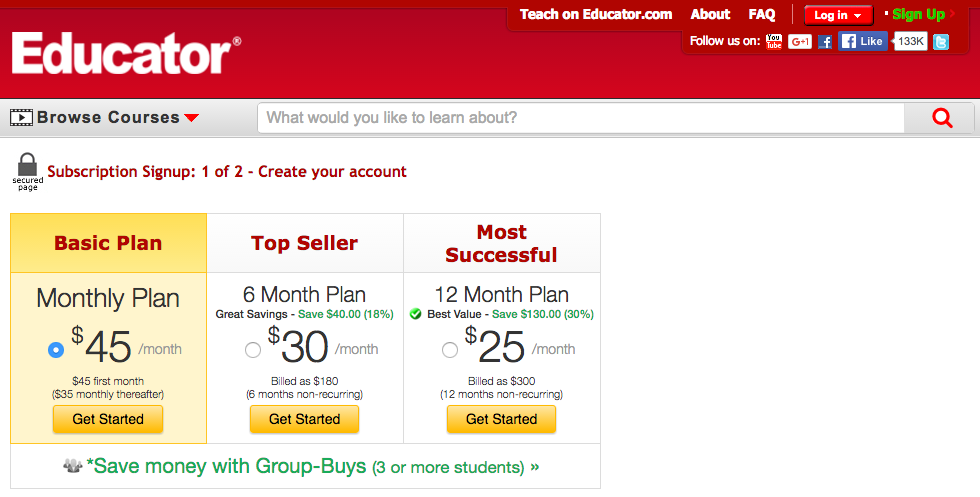
Source: Educator
Understanding Your Audience in Education
If you’re running an education company, then chances are you have multiple stakeholders that you have to worry about. School district leaders, teachers, parents, and students all have different needs, but they all need to be satisfied for a sale to go through.How do you market to all of them?
According to the EdTech Handbook, the first thing to think about is who your initial customer is. For example, you might start off by targeting teachers, but your ultimate goal is to close a deal with a school district. You might begin by offering free plans to teachers and students, but your objective is to sell a paid version to parents. Or you might go directly to your target market, even if they’re a massive entity.
Whatever the case, first focus on making your initial target users happy. This way, you can ensure that they’ll turn into advocates for your business, and help you get more customers and users through referrals.
In addition to this, there are a few sector-specific things to consider when marketing your product in EdTech:
- There’s usually a difference between users and buyers, unless you’re going directly to your target market. If this is the case, you’ll need to produce content at each stage of the funnel that hits the pain points of each stakeholder.
- Sales cycles with larger entities like school districts can take up to 9-18 months.
- Schools and teachers are, generally speaking, averse to change.
- Teachers are largely skeptical of trying out new technology because of poor technology that has been forced on them in the past. Instead of telling them why your product is better than everything else’s out there, show them how your product will solve their problems in the classroom.
- Even free products aren’t easy to sell. When adopting a new product into the classroom workflow, there often needs to be some sort of training involved, and there’s usually a short period of lost productivity right after the tool is introduced.
Now, let’s dig into actual examples.
Digital Marketing Case Studies
University College Dublin
University College Dublin (UCD) is one of Europe’s largest English speaking universities.
UCD wanted to better utilize their alumni base to help build out some of the university’s new programs, community, etc. But the problem was that they had an outdated website and a fragmented communication process. As a result, alumni support wasn’t as high as it should’ve been.
Emarkable, the agency that worked with UCD, focused on the following factors, according to the case study:
- Reach. They wanted to make sure that maximum number of people knew about the contributions of alumni to the school.
- Engagement. Emarkable used e-mail marketing, social media, and website updates to facilitate engagement between alumni and others within the university.
- Measuring. Emarkable kept track of metrics throughout the campaign so they could make sure that the limited resources were being put to good use. For example, metrics for e-mail marketing might include conversion rates, click through rates, and share/forward rates.
- Education. Teaching the alumni how to contribute to the university was also a major part of this process.
Ultimately, Emarkable used a content management system to redevelop the site and as a result UCD has been able to foster a better community among their alumni networks — and thus increase support for the university.
QA Higher Education
QA Higher Education (QAHE) aims to broaden access to higher education by both partnering with universities and hosting them. They also offer part-time masters programs in partnership with well-known universities in the UK.
QAHE wanted to increase their number of leads for a masters program on cybersecurity through search engine marketing and social media, so they worked with Touchpoint Digital and ultimately reduced their cost per acquisition (CPA) by 72%.
The target audience for QAHE was quite small: applicants need to live within a certain distance from the physical location in London and be interested in working in a relevant industry afterwards.
That meant that Touchpoint Digital had to make sure that the right type of people in the geographical region surrounding the university saw the ads. If they just blasted ads across the region, there there would potentially be thousands of wasted impressions.
They ended up developing a marketing campaign to help QAHE build awareness at the top of the funnel using social media — specifically retargeting and search advertising — to drive high conversions.
Marketing Funnel
Funnels start off at the ‘awareness’ stage, where the goal is to make more potential customers aware of your business. Then, move them on to the “interest” phase by capturing their email address in exchange for valuable content. From there, your goal is to move leads closer to making a purchase through evaluation-stage content until they’re ready to transact with you.

Source: Single Grain
Once you get people looking at your site, the next step is to move them onwards to the “interest” stage, where you present them with educational material like webinars, eBooks, email campaigns, etc to educate them about the problem around your product /service.
After potential customers are interested, then they’ll eventually start evaluating you against your competitors. At this stage, you’ll want to present them with persuasive case studies and whitepapers to show them the type of results you can deliver for them over other companies.
After the evaluation stage, it comes time to close the deal. At this stage, you’ll want to send them product demos, free trials, or sales calls.
The nice thing about marketing funnels is that you can evaluate how each “step” of your marketing process is performing. For example, you’ll know whether customers are dropping off at the “awareness” stage, “interest” stage, or if you’re just not able to convert them on a sales call, etc.
With a funnel, you can see exactly how many people are dropping off at each step, and you’ll know where you need to increase your conversions so that it translates to the bottom line. Here’s an example of what dropoff at each step might look like in an e-commerce marketing funnel:
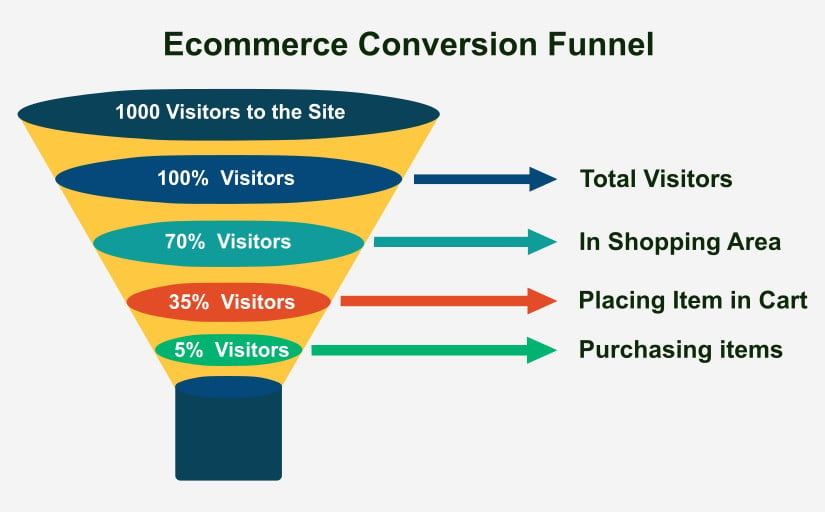
Source: Template Toaster
For example, if you notice that a lot of people are moving from the “evaluation” phase to a sales call, but they’re not converting, you know that your sales pitch needs some work.
If you’re getting lots of people in the “interest” phase, but they’re dropping off before they can get to a sales call, then chances are your engagement emails need some work.
You can take ideas from this systematic approach to building marketing funnels and apply it to your education company marketing strategy — but the truth is, the world of education has its own nuances.
For one, it can be a really fragmented industry, depending on what section of the market you’re targeting.
If you’re selling a product to universities or school districts, your marketing strategy will have to be different from companies that target parents or students. You might also have to deal with other nuances — if you’re selling a product to schools, then chances are your actual users will be teachers or students. So you’ll have to create a product that appeals to decision makers in schools as well as parents and students.
According to Bee-seen, the same fundamentals still apply. Here’s the three part sequence to closing a sale as an education company:
- Creating the right type of content. The first step is to create content that sells your product in the right way, through things like blog posts, lesson plans, case studies, etc.
- Acquiring new customers. Paid traffic, SEO, and social media are all examples of ways you can quickly zero in on your target audience and present them with the right content to bring them back to your own site.
- Conversion. Ultimately, getting visitors to your site is meaningless unless they turn into customers that keep coming back. This process requires detailed web analytics, retargeting, and creating a proper step by step funnel.
According to Pardot, 72% of buyers turn to Google once they realize they have a pain point. In this stage, customers are looking for educational material, such as blog posts, e-books, white papers, etc. This is why search advertising can be particularly effective.
Case Studies (contd.)
Central Saint Martins
Central Saint Martins is a public art school in London that offers a range of art and design courses. They turned to Touchpoint Digital to boost the number of applications received in 2015.
Similar to other small universities and education companies, CSM was working with a small budget in a highly competitive market.
Touchpoint Digital helped them build awareness at the top of the funnel for their short course offerings in order to help drive more applicants down the funnel.
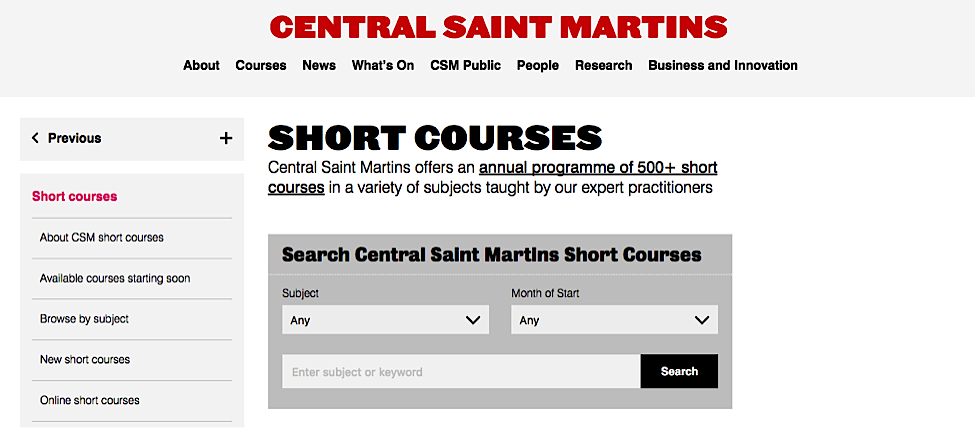
Central Saint Martin’s short course offerings
Ultimately, the boost in awareness helped Central Saint Martins drive 120% more traffic through Google search, and they were able to increase applications for their short courses by nearly 150%! ROI for the social media campaign was 190%.
When running social media campaigns for the top of the funnel, it’s important to have a reliable way to measure ROI so that you don’t get misled by the number of “likes” you get.
There are a variety of ways to measure social media ROI depending on what’s important to you, but here’s what Buffer suggests:
- First, choose a goal. Decide which goals and actions you want to track. For example, you might want to focus on getting new followers, more clicks on your status updates, more online purchases through social media, more signups for your e-mail list, or higher numbers for any other metric you want to drive.
- Next, track the goal. You can track certain website actions (i.e. sales, e-mail list signups, etc.) in Google Analytics. All you have to do is set up the right “goals” and “event tracking.” Using Buffer, you can track your number of followers and other top-of-the-funnel metrics in social media.
- Then, assign a monetary value to the goal. Once you’ve picked what goal you want to pursue and how to track it, you have to assign some value to that goal so you can put a dollar amount on it. This way, you can track your real ROI. Some numbers you could assign to your goals are:
-
Lifetime value
This number shows you how much revenue you generate over the “lifetime” of a customer’s interaction with your business.
-
Lifetime value x Conversion rate
This shows you how much each visit to your site is worth to you in dollar amounts.
-
Average order value
This shows you how much customers actually purchase.
-
PPC costs
This number represents how much you would have to pay to replicate the same results through paid traffic.
-
By getting clear on what numbers you want to drive through social media, you have a better chance of tracking how effective it really is.
Conclusion
The education industry is different from most others because there are almost always multiple stakeholders involved, and the person who you need to sell to is not always the person who’s buying your actual product.If you work with an agency, it’s important that they understand different business models in the education world, and how to adapt their marketing tactics to it.
What metrics do you want to drive for your education company? Let us know in the comments below.



